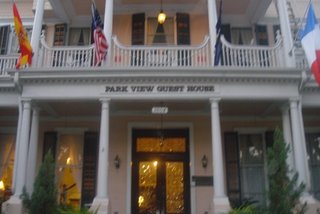Wendy and Suzanne are putting the caterpillars into numbered plastic bags with lots of the leaves from the plants they were eating. The baggies will go back to the lab, and the caterpillars will be fed, reared, and catalogued.
Wednesday, October 25, 2006
Caterpillars in the City
We found hundreds of these stinging green caterpillars in neighborhoods like St. Bernard Parish that that were badly flooded by Katrina last year. Can you guess what they are from the photos on Dr. Dyer's Caterpillars of Louisiana web site?
Tuesday, October 24, 2006
In the Field

Today some of us went to the Honey Island Swamp to collect caterpillars. Honey Island Swamp is a wooded section of the Pearl River Wildlife Management Area and is about a 45-minute drive from downtown New Orleans. To get to the area, we drove through the city past sections severely damaged by Katrina. It was strange to see stranded boats in the middle of abandoned malls and houses.
Grant Gentry, a senior researcher at the lab showed us how to mark off a 10-meter circular plot and look for the tiny clues ..freshly chewed leaves, caterpillar poop (frass) on the ground, rolled up dead leaves. Caterpillars are expert at camouflage.
At first it was hard to spot them. But after looking carefully at the undersides of leaves, we would begin to get better at noticing the tell-tale signs. We were able to cover four plots, and found 50 or so caterpillars ranging from big (2cm) spiny, stinging caterpillars to tiny, (4mm) twig like caterpillars.
Wendy stayed back at the lab working with Mark, the Lab Director. Check her site out for cool video clips of her in the lab and also Mark and Angela answering students' questions via video.
Monday, October 23, 2006
Meet the Team


We just arrived.. We are staying in an elegant Bed and Breakfast guest house across from Tulane University.
We had a brief tour of the lab and met 5-6 of Dr. Dyer's co-workers. Dr Dyer also gave us a brief introduction to his work. Then everyone, including the whole lab went out and played soccer. Evidently it is one of the first dry cool days. Lee mentioned that it is rare to have this kind of weather, and they take advantage of it. Soccer is one of the sports that he has taken up from his field work in Costa Rica and Ecuador!
After the soccer, our team of Laurie, Wendy, Mike, Dr Dyer, and Suzanne (left to right) went out to eat. Laurie, Wendy, Suzanne are teachers from MA. Mike teaches in MA.
You can look at videoclips of the lab and more photos at Wendy's web site (under Blog and Spotlights and Laurie's site. Suzanne's photos under "Ms York's page" on the Sierra Madre School site.
Also, check out Mike's site and photos of New Orleans hurricane damage. He and Suzanne came to New Orleans early to bring sweatshirts that their schools donated to Cherokee Elementary school in Pescagoula where students have been displaced by the hurricane..
Sunday, October 22, 2006
Useful Background
Forest Caterpillars Case Study. Description of Dr. Dyer's research in Costa Rica that explains "why caterpillars?" and parallels studies in New Orleans
Scholastic Explorers: Build a Caterpillar .Try your skill at creating a caterpillar that can defend itself from its predators!
Caterpillars in Louisiana. From Dr. Dyer's caterpillar website
Butterflies and moths of North America. Find out what’s in your state
Butterfly Life Cycle . Diagrams and photos of butterfly life cycles
Hurricane Katrina. Indepth look by BBC news of impact Hurricane Katrina has left on southern United States
Satellite images. Impact of Katrina onNew Orleans and environs
Monday, October 16, 2006
Getting Ready
WHEN: October 23-27, 2006
WHAT: Earthwatch Research Team, "Forest Caterpillars"
WHAT: Earthwatch Research Team, "Forest Caterpillars"
WHERE: New Orleans, Louisiana
Soon our team of five educators from California, Maine, and Massachusetts will be meeting Dr. Lee Dyer, a biologist and his assistants in the Department of Ecology and Evolutionary Biology at Tulane University in New Orleans. Dr. Dyer has been compiling data on caterpillar populations for over 10 years in Louisiana, Arizona, Costa Rica and Ecuador. We will be collecting information on caterpillars both in the lab and outside in forest ecosystems damaged by Katrina and Rita to understand the impact of the hurricanes on caterpillar populations. The Expedition Briefing describes in detail the goals of Dr. Dyer's research, the project location in New Orleans, and our daily schedule.
Subscribe to:
Posts (Atom)



